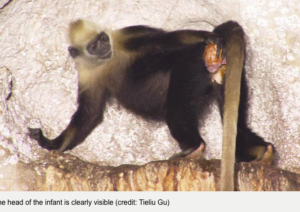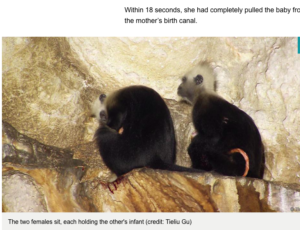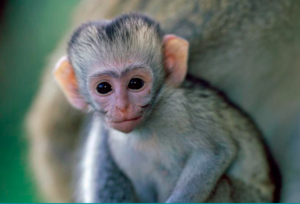Documented story by Japanese researchers of an experienced 5-times mother monkey midwifing a younger monkey giving birth for the 1st time
http://www.bbc.com/earth/story/20141006-the-monkey-that-became-a-midwife
Midwifery has been believed to be a unique human behaviour
Giving birth can be a wonderful, literally life-affirming event. But one extraordinary monkey has taken it to a new level; by acting as a midwife to another monkey in the act of having a baby. The incident is so rare it has never been recorded before in detail, or filmed or photographed.
It is also remarkable because, in the natural world, animals are destined to go through such a profound and difficult moment alone. Female animals usually give birth in private, and in solitude. Not for them the benefits afforded human mothers; the comfort and support of others, or their help and possible intervention to ensure all goes smoothly.
But scientists have witnessed a langur monkey being assisted in her birth by another female. The other female just actively approached her and took over, and pulled the infant completely out of the birth canal

The head of the infant is clearly visible (photo credit: Tieliu Gu)
Only once before has a monkey been seen acting as a midwife to another. In 2013, another group of scientists documented a black and white snub-nosed monkey aiding another in childbirth, but few details about the interaction were published and little was recorded about each monkey’s behaviour.
In contrast, scientists managed to document every step of the latest incident.
Meng Yao, an assistant professor at Peking University, Beijing and colleagues were researching a troop of white-headed langur monkeys living wild in China.
Though endemic to the country, this species is particularly rare, with fewer than 800 individuals living in the wild, making it among the world’s most endangered primates.
 As the baby’s shoulder also appears, the mother tries to help herself (credit: Tieliu Gu)
As the baby’s shoulder also appears, the mother tries to help herself (credit: Tieliu Gu)
“We had witnessed several births in the same group of langurs before this incident,” says Prof Yao.
Each time though, the monkeys had helped themselves give birth.
The phenomenon of ‘midwifery’ is almost unheard of in nonhuman primates
Uniquely among mammals, human babies usually face away from the mother as they are born. This, and the baby’s relatively large size, makes it almost impossible for a human mother to reach down to assist in her own birth by pulling the baby out.
In other primates, including monkeys, babies are born facing the mother, who can often assist her own delivery by pulling as well as pushing her baby out.
“The mothers always manually self-assisted the delivery, and other individuals only handled the infants hours after birth.” On one special occasion, however, things played out differently.
 The midwife monkey decides to intervene (credit: Tieliu Gu)
The midwife monkey decides to intervene (credit: Tieliu Gu)
In the journal Primates, Prof Yao and colleagues describe the events, which took place in the Nongguan Hills, in Guangxi, China, near Peking University’s Chongzuo Biodiversity Research Institute.
There, among a troop of male and female langurs, a five-year-old female went into labour for the first time.
As she was attempting to give birth, a second female intervened. This other female was 14 years old and had already given birth five times previously, including once earlier the same day.
Seeing one monkey act as a midwife to another came as a complete surprise to the watching scientists.
“The behaviour was totally unexpected,” says Prof Yao. “The other female just actively approached her and took over, and pulled the infant completely out of the birth canal. The mother complied immediately and did not show any resistance.”
 The midwife monkey pulls the baby clear of the birth canal (credit: Tieliu Gu)
The midwife monkey pulls the baby clear of the birth canal (credit: Tieliu Gu)
“The phenomenon of ‘midwifery’ is almost unheard of in nonhuman primates,” she adds.
The researchers managed to record the complete sequence of the birth with the behavioural details of the mother and the ‘midwife’ throughout delivery and their interactions afterwards.
Initially, the midwife monkey sat and watched as the younger monkey experienced more than 70 contractions.
She approached only once the baby’s head and shoulders had appeared.
She then stood on her hind legs and grabbed the emerging infant with both her hands, and pulled it towards her chest. Within 18 seconds, she had completely pulled the baby from the mother’s birth canal.
The two females sit, each holding the other’s infant (photo credit: Tieliu Gu)
As soon as it was born, the older monkey held the baby, and licked it.
Finally, the mother of the baby reached out to take it, and the older female let her do so without resistance. The midwife monkey then sat alongside the mother and child for a while.
The scientists can only speculate about the behaviour.
“Midwifery is a common practice in almost all human societies. But it has been believed to be a unique human behaviour,” says Prof Yao.
She says it may be more common among other primates than supposed.
But it is only likely to occur in primate species where females do not form hierarchies or compete with each other.
Macaques and baboons for example, are more likely to kidnap each other’s infants than help another mother give birth.
Very few births have been documented in wild apes, and none have yet been seen acting as a midwife.

